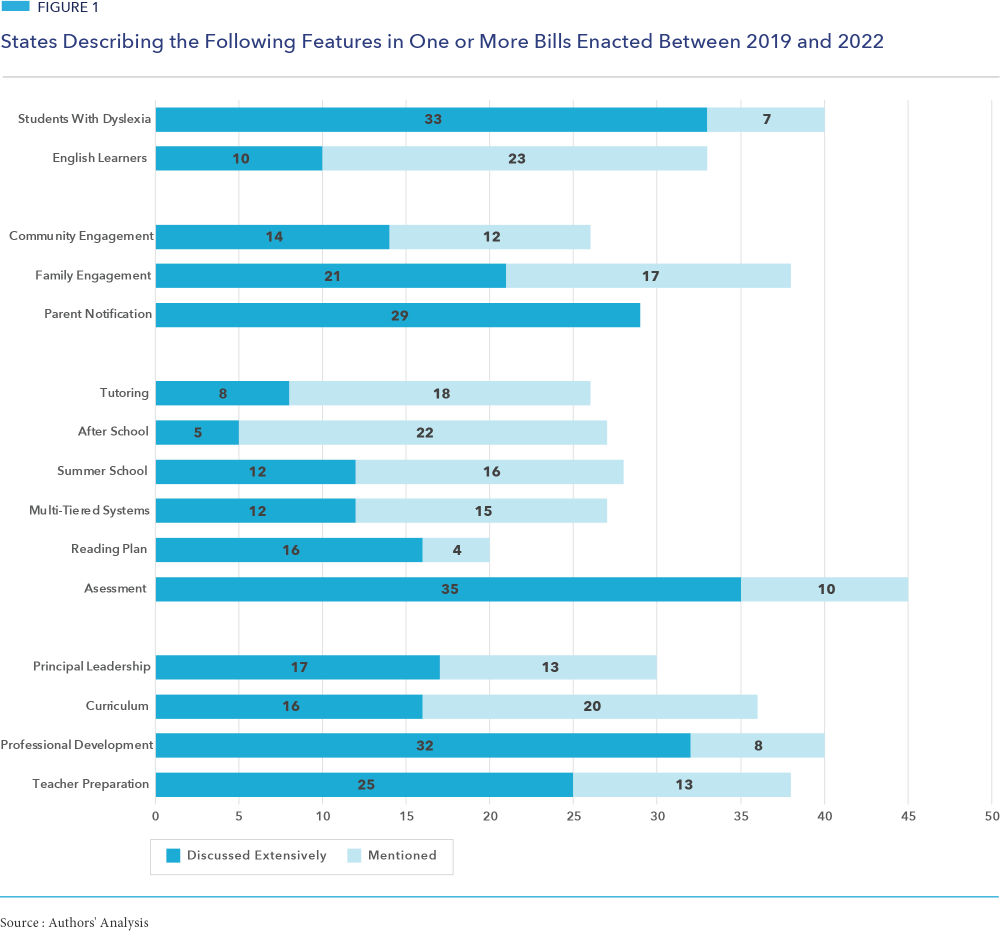Reading Reform Across America: A Survey of State Legislation

EXECUTIVE SUMMARY
Download: Full Report || Policy Recommendations || News Release || Executive Summary
In recent years, a scientific approach to reading education has gained traction due to the joint efforts of educators, parents, and state leaders. This movement for better reading instruction has helped to fuel a wave of legislation to address widespread and persistent reading deficits of American students. While reading difficulties cut across socioeconomic lines, they disproportionately affect students living in poverty as well as those from black, brown, and indigenous communities.

Reading Reform Across America documents how state legislatures nationwide have responded to these challenges. Specifically, the report examines reading-related legislation enacted between 2019 and 2022. We analyzed a total of 223 bills enacted in 45 states and the District of Columbia, examining over 40 features, such as teacher preparation, professional development, and curriculum, to name a few.
Our objective is to provide a robust and granular description of states’ efforts to enhance reading instruction, with the following goals:
- Foster constructive discussions that support states in developing effective roadmaps for advancing reading reform.
- Encourage states to devise supplementary policies (e.g., guidance, additional legislation) to address the areas needing improvement identified in this review.
- Appeal to the research community for assistance in filling legislative gaps, not only to align with current evidence-based principles and practices, but also to adapt to the evolving nature of scientific research.
KEY FINDINGS
First, the good news about our findings:
- Bills pay attention to the five pillars of reading, not just phonics. In most states (34), laws reference the pillars identified by the National Reading Panel report, namely phonemic awareness, phonics, vocabulary, fluency and comprehension.
- Laws are targeting more students than previous legislation. Forty-two states passed laws covering students from kindergarten to beyond 3rd grade, with 31 of these also including pre-K, and 37 charter schools. Only 12 states enacted laws exclusively targeting Title I schools.
- Legislation is bipartisan and state driven. Comprehensive reading laws have been enacted in both traditionally conservative and traditionally progressive states. This report features exemplar legislation from states across the political spectrum.
- Focus on evidence. A commitment to evidence-based practices and materials underpins the legislation, with all but four states explicitly articulating this objective.
- Pre-service preparation and professional development are a main focus of this legislation.
- Family involvement in literacy — the active engagement of family members in supporting and enhancing a child's reading skills and habits at home and in collaboration with schools — is significantly addressed in the laws of 38 states, with 21 giving it thorough consideration.

Our analysis also revealed limitations that could affect the success of these laws:
- Oral language and writing receive less attention than the Five Pillars although many studies have established their crucial role in reading. Background knowledge, another critical pillar, is mentioned in legislation from only six states.
- Assessment is prioritized, yet comprehensive supports for students receive limited attention. Only two states, Florida and Michigan, enacted bills extensively discussing all these supports.
- Teachers take center stage, but additional supports are crucial. Only about one-third of states enacted legislation that delves deeply into curriculum or school leadership, with a mere 11 states extensively addressing both areas simultaneously in their laws.
- Unequal attention to student groups. Dyslexia gets a lot of attention, with laws in 33 states thoroughly addressing students with dyslexia. However, English learners are less emphasized; laws in only 10 states discuss this population in-depth.
- Community engagement receives limited focus. While 26 mention community initiatives in their legislation; only 14 of these discuss community engagement in more detail.
- Fragmentation and missing links. Most bills pay limited attention to alignment and coherence across different aspects of reading education, suggesting an insufficient focus on how various components of the system interact.
EXEMPLARY STATES
We have featured nine states for their legislation’s leadership in specific domains:
- Alaska gives families a voice in their children's literacy education.
- Arizona uses a holistic approach to defining reading.
- California is considering the needs of English learners and emergent bilinguals.
- Colorado demonstrates a commitment to community engagement around reading.
- Delaware provides an example curriculum aligned with professional development.
- Kentucky’s legislation recognizes writing instruction as a key component of literacy.
- Michigan offers a comprehensive set of supports for students.
- Texas has legislation that outlines professional development across grade levels.
- Utah’s legislation focuses on developing capacity-building leadership.
CONCLUSION

The report's companion website features an outline of our policy recommendations, a succinct factsheet, and tools to download and explore the legislative data.
Collectively this legislation represents the boldest, broadest and most scientifically grounded effort our nation has put forward to strengthen reading instruction for all children. Still, our report identifies opportunities for states to pursue more systemic and coherent laws that lay a solid foundation for literacy improvement. Specifically, what raises concern is the unequal focus on different student groups by states, paired with an emphasis on screening and assessment that isn't balanced with a corresponding commitment to comprehensive student supports. Similarly, teachers’ knowledge about scientifically based reading instruction isn’t enough; additional supports like effective school leadership and high quality curriculum are indispensable for educators to apply their knowledge and achieve results with students.
The voices of educators and families should be integral to the legislative process shaping reading instruction. A collaborative approach is more likely to result in stronger policies, and to garner support from those who are closest to students and who will lead the way in putting these policies into action. By contrast, excessive rigidity, such as banning specific practices or curricula — a feature that appears to be increasingly common — can undermine this collaboration and prove impractical. Positive interactions rooted in respect for educators and families will be pivotal to the success of reading policy. Mississippi, a state that championed reading reform well ahead of the legislative wave analyzed in this report, has seen significant improvements in reading. These gains are tied not only to the technical aspects of the reforms, but especially to the collective endeavor of teachers, leaders, and communities in implementing them. Mississippi's experience illustrates that the path to improvement is a continuous, collaborative journey.
Finally, we hope that this report does more than just provide an update on state initiatives. Our analysis and recommendations are intended to be a catalyst for a more unified approach to reading reform, one that enhances our capacity to support every student.
